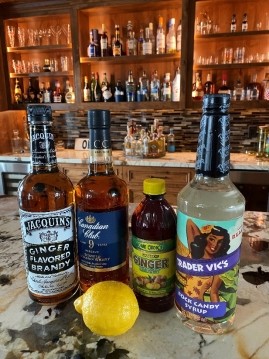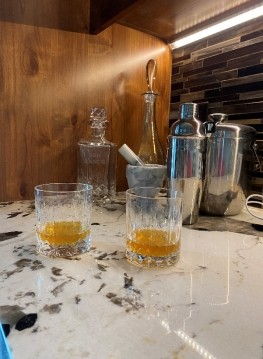
The Flu Cocktails at Harry’s New York Bar and at the Ritz bar were similar, suggesting it may have been a common drink in the 1920s rather than a specialty of a particular bar or bartender. The drink served as a memento of past times but also as a memento mori of how quickly influenza might return and life turn to death. At Harry’s, the Flu Cocktail was made of a dash of Jamaica ginger, a teaspoon of lemon juice, a teaspoon of rock candy syrup, a teaspoon of ginger brandy, and one glass (i.e., a shot) of Canadian Club Whisky. These ingredients were stirred together and served in the same glass (MacElone 12). The recipe for the Flu Cocktail at the Paris Ritz, included by bartender Piero Grandi in his 1927 edition of Cocktails, contained the same ingredients as Harry’s, except that the main alcohol was Rye whisky (Grandi 35). However, this wasn’t as different as it might seem since Canadian Club whisky and Rye whisky were viewed as interchangeable at the time.1
Even without taking a sip, one might anticipate from the recipe that the Flu Cocktail was potent enough to make customers believe they were coming down with the flu. More likely, it was intended to simulate the experience of throwing back something strong enough to hopefully knock the flu out of their system. The drink was a reminder that folk remedies, often involving alcohol on its own or in combination with other ingredients, were used to combat any number of ailments and had been especially popular during the 1918-19 pandemic.2 This was due, in part, to people’s desperation to find something that might prevent, treat, or cure influenza. The Flu Cocktail also contained signs of just how far many Americans went during Prohibition to obtain alcohol.
For instance, Canadian Club Whisky was the most smuggled whisky in America during Prohibition (Canadian Club, “Our Story”). In addition, Jamaica ginger extract, with the slang name “jake” (an interesting coincidence given the name of Hemingway’s protagonist), was a late 19th-century patent medicine that, mixed with water, had a reputation for being an effective therapy for upper respiratory infections, nausea, digestive issues, and headaches (Fortin; Wikipedia). It became popular during Prohibition as a means for obtaining alcohol legally given that it contained 70-80% ethanol by weight but was sold as a medicine. Indeed, its popularity led to a tragic outcome in 1930, several years before the end of Prohibition, when an adulterated version caused paralysis in thousands of Americans due to a neurotoxic compound called triorthocresyl phosphate (TOCP) that had been added to it (see, for example, Morgan and Penovich; Davis 13-18). Their condition was known as ginger jake paralysis or jake leg (Davis 15), and it was memorialized in songs such as the “Jake Walk Blues” (gait impairment was one of the effects of the tainted drink).
In our own time, we, too, have extensive experience with a lethal pandemic and are thus aware of the extremes people can go to in seeking protection, relief, or a cure for a contagious virus. Fortunately, our scientists and medical professionals were quickly able to develop a vaccine and antiviral drugs that helped to stop the spread of the virus and mitigated some of its more dangerous effects.3 Still, I am interested to know what it must have felt like for people of Hemingway’s and my grandparents’ generation (my grandfather served in the U.S. Army in World War I and was stationed in France) to live more precariously on the edge of wondering when they, their families, their friends, or their communities might be struck with the terrible flu. For this reason and because I was just plain curious, I tried the Flu Cocktail.
I first had to track down the ingredients, eventually buying almost all items online, including the alcohol (Canadian Club Whisky and Ginger Brandy), which I purchased from companies that sell and ship alcohol online. The most difficult ingredient to acquire was Ginger Brandy not because it is scarce but because few liquor outlets with an online presence would ship it to my home in Nevada. When I finally found a store that would send it to me, the shipping cost more than the brandy. The only item I bought locally was the lemon.
With all ingredients on hand, I carefully followed the recipe provided by Harry MacElone (1890-1958) in Harry’s ABC of Mixing Cocktails. Harry bought the New York Bar of Paris in 1923, renaming it Harry’s New York Bar. It became a favorite watering hole of artists and writers, including Hemingway. Below are photos of my bartending effort. I confess I was skeptical I would enjoy this drink. I thought it would taste more like medicine than a cocktail with the rock candy syrup serving as the proverbial spoonful of sugar to wash it all down.

I talked my spouse into trying the Flu Cocktail with me, and to our surprise, “it wasn’t that bad,” as we both said almost simultaneously after our first taste. We also agreed that it was strong. But I did drink the whole drink, as did my spouse (in between sips of water and 7-Up), so that is some measure of our toleration of the drink. I also had a headache when I started drinking, but it disappeared afterwards. That could have been the placebo effect, but I also didn’t have the flu, so I have no idea whether it would have worked similarly with the illness it was intended for. There are limits to how far I will go for research. Deliberately catching the flu is definitely beyond my threshold.
1 “In Canada, ‘rye’ has been synonymous with ‘whisky’ for several centuries” (de Kergommeaux).
2 Arlene Keeling notes that nursing was essential for influenza patients, but “in 1918, there was minimal understanding of the disease, and no antiviral medications to inhibit its progression or antibiotics to treat the complicating pneumonia that often followed. Instead, Vick’s® Vapo Rub, aspirin, bedrest, sponge baths, whiskey, cough medicines, clean bedding, and hot soup were among the therapies most often prescribed—all administered most effectively by trained graduate nurses who had learned to use these therapies in nursing school” (p. 106; emphasis added).
3 Not until the 1930s did scientists confirm that the 1918-19 influenza was a virus; before then, many believed it was a bacteria. Thus, no effective vaccine could have been developed. As Nancy Bristow observes, the Surgeon General repeatedly reminded Americans that “without the identity of the causative agent, vaccines could be little more than exploratory and were simply ‘not reliable’” (97). Nonetheless, during the 1918-19 pandemic, public health leaders sometimes promoted the use of vaccines, “often employing them as a prophylaxis against fear rather than influenza, or in order to facilitate research on prevention and cure” (Bristow 97).
Works Cited
Bristow, Nancy K. American Pandemic: The Lost Worlds of the 1918 Influenza Epidemic. Oxford UP, 2012.
Canadian Club. “Our Story: 1920’s Gangsters, Bootleggers.” www.canadianclub.com/our-story.
Davis, Frederick Rowe. Banned: A History of Pesticides and the Science of Toxicology. Yale UP, 2014.
de Kergommeaux, Davin. “The Essence of Canadian Rye.” CanadianWhisky.org, 5 Nov. 2011, web.archive.org/web/20131231001147/http://www.canadianwhisky.org/news-views/the-essence-of-canadian-rye.html.
Fortin, Neal. “Jamaican Ginger Paralysis.” Michigan State University Institute for Food Laws and Regulations, 28 September 2020, www.canr.msu.edu/news/jamaican-ginger-paralysis.
Grandi, Piero. Cocktails. 3rd ed., Rome, 1927. euvs-vintage-cocktail-books.cld.bz/1927-Cocktails-by-Piero-Grandi/II.
Keeling, Arlene W. “‘Alert to the Necessities of the Emergency’: U.S. Nursing During the 1918 Influenza Pandemic.” Public Health Reports, vol. 125, issue 3 supplement, 2010, pp. 105-112, doi.org/10.1177/00333549101250S313.
[MacElhone, Harry]. Harry’s ABC of Mixing Cocktails. c. 1920. Reprint Martino Fine Books, 2017.
Morgan, J.P., and P. Penovich. “Jamaica Ginger Paralysis: Forty-seven-Year Follow-Up.” Archives of Neurology, vol. 35, no. 8, 1978, pp. 530-32, doi: org/10.1001/archneur.1978.00500320050011.
Wikipedia. “Jamaica ginger.” en.wikipedia.org/wiki/Jamaica_ginger.
Debra A. Moddelmog is dean of liberal arts emerita at the University of Nevada, Reno. She co-edited Ernest Hemingway in Context with Suzanne del Gizzo and is the author of Reading Desire: In Pursuit of Ernest Hemingway. Her edition of The Sun Also Rises was recently published by Broadview Press. Feedback can be sent to dmoddelmog@unr.edu